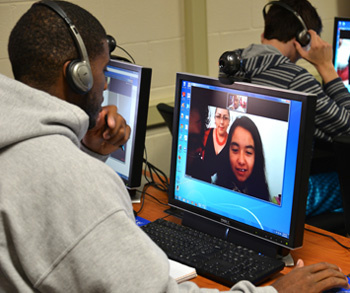By Robin M. Helms
Over my morning coffee a couple weeks ago, I read an article in my alma mater’s alumni magazine, the Princeton Alumni Weekly, about a fantastic study abroad program Princeton recently launched in Cuba. Having made my career in international education—including designing and implementing study abroad experiences for American students—I was highly impressed. A small group of students spent a semester in the rapidly-changing country as part of a beautifully designed program that was both immersive and supportive, and allowed them to experience, reflect and grow both academically and personally.
Quotes from students on the program are textbook examples of the kind of learning we all hope will take place during study abroad experiences. They reflect nuanced insights about the culture and history of the host country and the students’ own cultures and values, as well as a sense of connection to and genuine interest in the well-being of the Cuban people.
A few of the many examples include:
“I’m worried about who is going to benefit from the opening up. Prices will rise, but will wages rise too?”
[On the way home] I was coming from a country with no internet, and at Newark airport, everyone has an iPad…Maybe it’s not that Cuba needs to change, but the U.S. We have all these things that are over-the-top ridiculous that we could do without.
“[In Cuba] there is such an emphasis on strengthening relationships. Four-hour conversations are okay. In the U.S., it’s like time is money.”
“[The semester in Cuba] really led me to re-evaluate what I value. Cuban advances in health care and education came at a price. They came at the price of freedom of speech, of human rights violations, and one has to ask if it was worth it. The answer is, I don’t know. That’s something I am still thinking about.”
This is global learning at its best. In the increasingly globalized world of the 21st century, colleges and universities are recognizing the need to provide students with the knowledge and skills needed to live and work across borders. Indeed, when asked about their rationale for internationalizing, respondents in ACE’s most recent Mapping Internationalization on U.S. Campuses study ranked developing student global competence as a top goal. Study abroad is often seen as a primary means by which students can gain this competence.
The big problem, however, is that in the United States, so few students ever have this type of experience. The newest Open Doors numbers from the Institute of International Education, released just this week, indicate that the study abroad rate among U.S. students still hovers just below 10 percent. And we’ve all read about the trend toward shorter and shorter abroad experiences. While short programs certainly still have merit, the percentage of American students who participate in programs like Princeton’s is undoubtedly much smaller. As access to higher education continues to increase, and our national student body is comprised of more adult learners, working students, and others for whom taking time away from home is not a realistic option, the feasibility of study abroad as the primary means of delivering global competence will decrease even further.
To borrow a phrase from the activist community, we need to turn our collective attention to the other 90 percent. How do we make sure that ALL students—not just those who are internationally mobile—have opportunities to gain global knowledge and grow academically and personally in the same ways as the Princeton students in Cuba?
Here at ACE, we’ve been addressing this challenge by focusing on internationalization of the on-campus curriculum and co-curriculum, and how institutions can bring global perspectives into the classroom and into student life more broadly. We know, for example, that technology can play an important role in connecting classrooms across borders, and bringing about the sorts of cross-cultural interactions that promote global competence. Often, the technology itself is simple—it’s a matter of finding creative uses for it to facilitate globally focused course content.
 Attention to faculty issues is a key piece of the equation as well. Professional development opportunities and other support are needed to make sure faculty themselves are globally competent, and can help their students gain the knowledge and skills they need to achieve this competence themselves. Our new report, Internationalizing the Tenure Code: Policies to Promote a Globally Focused Faculty, highlights ways that institutions are incentivizing faculty to engage globally and bring an international dimension to their work—and importantly, how they are rewarded for this.
Attention to faculty issues is a key piece of the equation as well. Professional development opportunities and other support are needed to make sure faculty themselves are globally competent, and can help their students gain the knowledge and skills they need to achieve this competence themselves. Our new report, Internationalizing the Tenure Code: Policies to Promote a Globally Focused Faculty, highlights ways that institutions are incentivizing faculty to engage globally and bring an international dimension to their work—and importantly, how they are rewarded for this.
 With advocacy as part of ACE’s mission, we also have recommended that the federal government has a role to play, one that should be expanded going forward. As we note in Internationalizing U.S. Higher Education: Current Policies, Future Directions, U.S. federal government policies and programs that support higher education internationalization are largely skewed towards facilitating student mobility. Those few initiatives that address curriculum, such as the Department of Education’s Title VI programs, are underfunded and reach only a small percentage of U.S. students.
With advocacy as part of ACE’s mission, we also have recommended that the federal government has a role to play, one that should be expanded going forward. As we note in Internationalizing U.S. Higher Education: Current Policies, Future Directions, U.S. federal government policies and programs that support higher education internationalization are largely skewed towards facilitating student mobility. Those few initiatives that address curriculum, such as the Department of Education’s Title VI programs, are underfunded and reach only a small percentage of U.S. students.
More government-sponsored policies and programs that facilitate institutional efforts to internationalize the curriculum and promote global competence among faculty would help us along the path toward “global competence for all.” Certainly, our country would benefit tremendously—economically, politically, and socially—from a more globally competent and engaged workforce and citizenry.
Should we abandon study abroad? Absolutely not. But we owe it to our students—all 100 percent of them—to make sure that international perspectives and knowledge are infused throughout their educational experience from start to finish, on-campus and beyond.
If you have any questions or comments about this blog post, please contact us.

